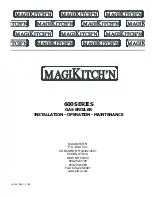
USER MANUAL CENTRAL HEATING STATION TYPE C15SPV24MEFM / C17SPV31MEF
8 din 17
8.5
Connecting pipe of the safety valve
Caution!
Danger of hot water burns!
The connecting pipe of the pressing of the safety valve is connected to the drain pipe to the sewage system.
Otherwise, there is always the risk of flooding, for which the manufacturer of the central heating station is not responsible.
8.6
Air/ burnt gases input/ output pipes
The central heating station does not use air from the room where it is installed or from the neighbouring rooms. Admission of air
necessary to an efficient and not dangerous burning is always from the outside.
Caution!
The kit will obligatory have an incline of 3% (approximately 2°) in order to eliminate condensation towards the exterior.
It is obligatory to install central heating stations in rooms with ventilation in accordance with applicable norms.
Danger!
It is forbidden to run the station without the air/ burnt gases input/ output pipes because it endangers the life and health
of people. Installation is carried out only by authorized personnel using original spare parts provided by the
manufacturer.
Caution!
In order to obtain the efficiency declared by the manufacturer, while at the same time observing the limits of
compounds from resulting burning gases, it is necessary to mount the diaphragms delivered with the central heationg
station.
8.7
Electric grid connection
The central heating station must be connected to one-phase network of 230V - 50Hz with protection null.
Dispersion withstand of the earthing switch (earthing) must comply with applicable norms (maximum 4 ohm, and the working
null must not have residual current).
Electric powering of the central heating station will be executed from a separate circuit provided with differential protection
fuses of 30 mA.
External connections must comply with applicable norms. Connection to the electric grid of the building must allow the entire
electric insulataion of the central heating station for situations when interventions are required.
Grid connection is done taking into account the symbolism of colours as follows:
Brown
= phase,
Blue
= null,
Green and Yellow
=
earthing.
The current plug must be accessible so that the user can easily disconnect it.
Caution!
It is not allowed to mount the central heating station with a defective electric installation or with no earthing.
Danger of death by electric shock with electric contacts!
8.8
Installation filling and emptying
The following operations are executed to fill the installation:
- electrically power the central heating station;
- open the filling tap (fig. 1.4) of the central heating station and of the thermal/ house water installation:
- charge the boiler with a pressure of 0.4 bar shown on the display;
- open the air vent of the pump;
- activate the boiler pump to air the installation: for activation long press J7
(
) and the pump will turn on, while the central heating station is OFF
(Stand-by);
- set the needed hydraulic characteristic on the pump (5, 6 or 7 m H2O);
- continuue to charge the boiler up to
1.5 bar
, pressure shown on the
display;
- close the filling tap of the central heating station;
- check the system to be water-proof. If there is leakage, solve the problem;
- leave the pump on until all noises on the installation stop. It is needed 2-3
complete airvent cicles of 50-60 sec each;
- airvent the radiators;
*figure conains ERP pump
- check the pressure in the installation shown on the display. If necessary, fill with thermal agent observing the above mentioned
steps;
- turn off the station pump by pressing
J7
(
) or by turning on the station by pressing POWER.
Caution! Obligatory operation!
Check the correct functioning of the pump with no fuel in the central heating station.
Defficient thermal transfer can cause the melting of the vent pipe of the ventilator, errors of the central heating station
damage of the main switch of the station.
Incorrect airing of the installation can cause damage of the main heating switch.
Note!
Recommended pressure on the thermal circuit is 1.5 bars.
Fig.1.4



































